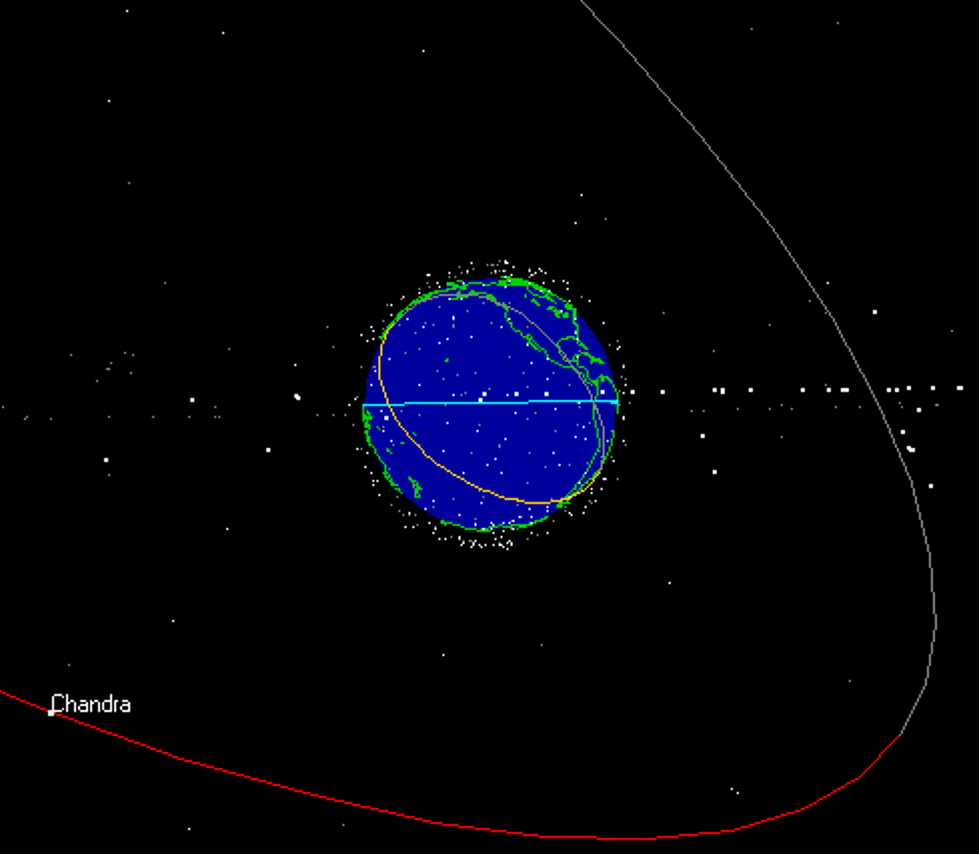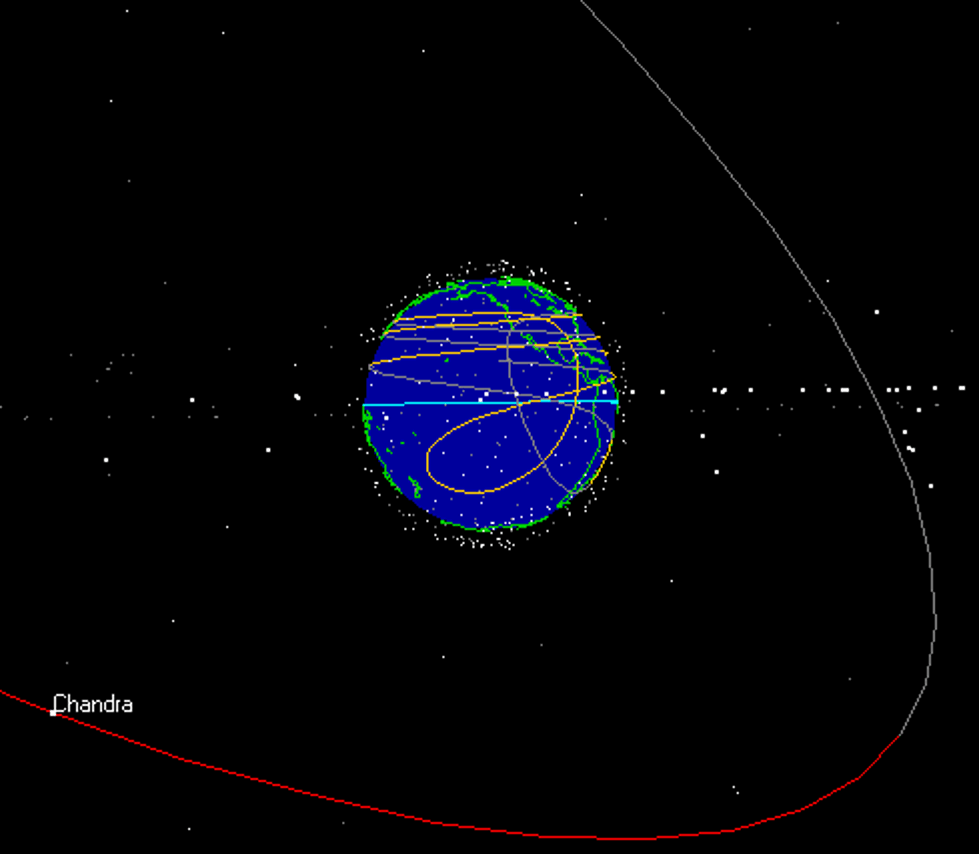


Science and Faith
Science and Faith
Catholic Outlook
Catholic Outlook

Catholic Outlook
Science and Faith
Science and Faith
__________ Recent Additions __________
Catholic Outlook
Catholic Outlook
Dialogue on Satellites with Extremely
Eccentric Orbits (Part 2)
How the flightpath of NASA’s Chandra X-Ray Observatory proves that the earth is rotating
Gary Hoge
__________ About this Dialogue __________
A continuation of my dialogue with Catholic geocentrist Bob Sungenis. My words are in black, and Bob’s are in blue.
Here’s Bob Sungenis’ latest attempt to explain how the Chandra X-ray Observatory can follow this pattern over a stationary earth:

Obviously, Gary still doesn’t understand what I was saying. I said the computer charts the pattern as if the earth were rotating. Chandra isn’t making the lines on the graph, the computer is.
Yes, but those lines represent Chandra’s actual flightpath relative to the ground.
The computer can do nothing else than what is put into it. If the computer is programmed to assume a rotating earth, then it must chart the course of Chandra on the earth AS IF someone on the ground watching Chandra were rotating against Chandra’s orbit every 24 hours. Since Chandra’s orbit is at an incline, this will account for the vertical lines on the graph. Since Chandra is circling west to east around the earth, this will account for the horizontal lines on the graph. But this doesn’t mean the earth is rotating. It could also mean that the earth is actually stationary but that the computer must figure out what a graph would look like if the earth were rotating and Chandra’s whereabouts, with respect to a specific spot on the earth, needed to be charted.
You still don’t seem to get what’s happening here, Bob. That meandering line is Chandra’s actual flightpath over the ground. That’s where you have to aim your telescope if you want to see the satellite. If that line predicts that Chandra will pass over eastern Nevada, on a north-south heading, that means that an astronomer in eastern Nevada would be able to point his telescope straight up at the appointed time and see the satellite. If that line didn’t represent Chandra’s actual flightpath over the ground, astronomers wouldn’t be able to use that ground-track data to aim their telescopes.
Now, it being the case that this is Chandra’s actual flightpath, our two respective systems must explain how a satellite can pass over the surface of the earth in that squiggly, loopy pattern. In my system, the trajectory is easily explained as the superimposition of an elliptical orbit over a rotating earth. But in your system, where the earth doesn’t move, only the satellite moves. Therefore, the satellite must somehow steer itself along that wild, squiggly, loopy course. How does it do that?
If you then tell the computer that the earth is stationary and ask it to tell you Chandra’s whereabouts with respect to a specific spot on earth, it will do so, but it will make a chart on the graph which is different than the squiggly lines in Gary’s original graph.
Right, and if you then aim your telescope where this new graph predicts the satellite will be, it won’t be there.
Both graphs are true records of the systems they represent, but neither graph proves that the system they represent is the actual system operating.
These aren’t graphs of cosmological systems, they’re graphs of the actual flightpath of a satellite relative to the ground. That satellite either passes over the specific places NASA’s graph says it will, or it doesn’t. Under no circumstances, though, can two different ground-tracks both be “true.” One represents where the satellite will pass over the ground; the other does not.
Previous:
The point of my previous post, to put it crudely, is that Chandra does not have a big pencil that reaches to the earth and by which it marks out a trajectory.
But if it did, it would mark out exactly the trajectory shown on NASA’s maps. Again, the fact that astronomers use this same trajectory data to aim their telescopes proves that Chandra is right where NASA says it will be relative to the surface of the earth.
No, it only proves that the system they are using will account for Chandra’s whereabouts with respect to a rotating earth, but it does not prove that the system is a reality, that is, that the earth is rotating.
Then please tell me how a satellite can follow that squiggly, loopy trajectory over the ground if the earth isn’t rotating. You keep avoiding that question.
Previous:
Once again, the image we see in NASA’s pictorial is exactly what one would expect to see from a rotating earth. But that doesn’t prove that the earth is rotating. All it proves is that if one assumes a rotating earth, the trajectory will follow the path depicted in the pictorial.
No, the satellite follows that trajectory whether the earth rotates or not.
No, Gary hasn’t shown that. He hasn’t asked NASA to produce a pictorial of Chandra’s lines assuming a non-rotating earth. NASA could do so if they wished, or if Gary asked them.
Again, the lines I showed represent Chandra’s actual flightpath over the ground. You yourself acknowledged this when you said that this chart showed that “Chandra is going to be over a certain place at a certain time.” Exactly! Now, how do you account for that flightpath if the earth is stationary?
Previous:
In other words, if you’re standing somewhere on that looping yellow line, and you look up at the right time, you’ll see the Chandra satellite. If the earth rotates, the ground-track makes sense. It’s simply the result of superimposing a highly elliptical orbit over a rotating globe.
Yes, you will see Chandra, but that’s because the computer has already shown you where the line of sight would be assuming that the earth is rotating.
Whether the earth is rotating or not, that line represents where the satellite will actually be relative to the ground. The ground, you’ll recall, is where the telescopes are that use this data to aim themselves at the satellite.
Gary must realize, and it has been hard for him to do so throughout these dialogues, that his system is not the ONLY one that can explain the motions we see in the sky.
If you can explain how Chandra loops and twists around a stationary earth, I’d love to hear it. If you can’t, then I think you should concede that this inexplicable flightpath proves that the earth is rotating.
He thinks that just because his system works, then it discounts all other systems.
This flightpath discounts yours. Unless, that is, you can explain how a satellite can flit around a stationary earth like a moth around a porchlight.
But that is a fallacy. I think you’ve all seen those tricky drawings that, if looked at in one way, the drawing looks like a lamp. If looked at another way, it looks like two people kissing. Same principle here.
Are you saying this flightpath is an optical illusion? If I look at it a certain way will I see a profile of Galileo?
You’ve admitted that this flightpath is an accurate representation that shows that “Chandra is going to be over a certain place at a certain time.” That’s how astronomers are able to aim their telescopes at it. It’s also how flight-controllers are able to aim their signals at it. If the computer that draws this accurate flightpath must make certain assumptions to draw it, I’d say the fact that the satellite is where the computer says it will be is proof that those assumptions were correct.
Previous:
But if the earth isn’t rotating, that means that somehow Chandra is able to go looping wildly around it, like a bee circling its nest. Bob needs to tell us how that happens.
No, because I’m saying that if the earth were not rotating, then the computer would not make all those squiggly lines. It would make a simple horseshoe shape or thereabouts.
Yes, but Chandra doesn’t follow a horseshoe shape relative to the ground. It follows the squiggly shape I showed you. This proves that the earth is rotating.
Previous:
Yes, if the earth weren’t rotating, a satellite in an elliptical orbit would follow a simple trajectory relative to the ground. But because the earth is rotating, that satellite follows the bizarre trajectory shown in the image above instead. But whether the earth is rotating or not, that is Chandra’s actual flightpath over the ground. That’s where you have to aim your telescope if you want to see it. How can Bob account for that flightpath if the earth isn’t rotating?
I’ve already accounted for it by saying that the flight path is what an observer would see from earth based on a rotating earth.
Well, since that’s what an observer does see, the earth must be rotating.
The computer gives that to him. The computer will say to him: “If you want to see Chandra, be at such and such a location at such and such a time” and it will be correct. Or the computer can say: “Point your telescope in such and such a direction at such and such a time” and you will be able to see Chandra. Why? Because the computer has already assumed a rotating earth.
Right, and if that assumption had been wrong, the computer’s telescope-pointing instructions would also be wrong. Garbage in, garbage out. But if an astronomer follows those computer-generated instructions, he will see the satellite, right where it should be.
But you could also tell the computer that the earth is not rotating and then the computer will come back and tell you: “Be at such and such a place at such and such a time” and you will be able to see Chandra.
No, you won’t. The same satellite can’t follow two different flightpaths over the ground at the same time.
In both cases, the computer will give you the exact same location, whether its for a rotating earth or a stationary earth. The only thing that will be different is the trajectory line the computer traces out in each system.
Bob, the “trajectory line” is nothing but a plot that strings together the satellite’s location at consecutive time intervals. Thus, it is nonsense for you to say that two different trajectory lines will yield the “exact same location.” If one trajectory says Chandra’s passing over southern Virginia while another trajectory says it’s passing over Hawaii, they can’t both be right. And only one of those trajectories will accurately tell you which way to aim your telescope. The fact that the rotating-earth trajectory accurately predicts Chandra’s location in the sky proves that the earth is rotating.
It just so happens that the horseshoe trajectory of the stationary earth will circumscribe the zig-zagging and looping trajectory of a rotating earth AT EVERY POINT, since both systems account for Chandra’s whereabouts at all times.
No, they don’t. Chandra is orbiting in an ellipse. If the earth weren’t moving, it would trace-out a path over the ground that looks like this:

That’s very different from its actual path over the ground, which looks like this:

You need to explain how Chandra is able to move in such a crazy pattern relative to the ground if the ground isn’t moving.
Previous:
Except that if the earth isn’t rotating, then Chandra isn’t in an elliptical orbit; it’s in a bizarre, spirally, loopy orbit. Mathematically, you could assume that the earth is stationary, and that Chandra is moving in a bizarre, spirally, loopy orbit. But in real life, it’s just not possible for a satellite to move like that (not without a lot of fuel and a very powerful rocket). Therefore, we can rule out the idea that the earth is stationary. Instead, the flightpath over the ground followed by Chandra is the result of superimposing its simple elliptical flightpath over a rotating earth.
No, because you’re basing that answer on the graph NASA gave you, not on proof that the earth is rotating.
The graph NASA gave me is Chandra’s actual flightpath over the ground. That’s the trajectory data that astronomers successfully use to point their telescopes at Chandra. That ground-track is only explicable if the earth is rotating, and that proves that the earth is rotating.
If NASA’s computer graph is made by merely assuming a rotating earth, then the graph doesn’t prove anything for you.
It does if Chandra actually follows the path over the ground that NASA’s rotating-earth calculations predict it will. And you’ve already conceded that it does. Therefore, whether you realize it yet or not, you’ve conceded that the earth rotates. Unless you can come up with a plausible explanation of how a satellite meanders in crazy loops and zigzags around a stationary earth.
Hence, Chandra wouldn’t have the “bizarre, spirally, loopy orbit” that you claim, since you are basing that answer on an unproven premise that the computer graph represents the ONLY possible reality.
It represents the reality of Chandra’s flightpath over the ground. That’s the reality we both have to account for in our respective systems. If the earth is rotating, this pattern makes sense. How do you account for it if the earth isn’t rotating?
First of all, let me apologize for accusing Gary of a “charade.” I got a bit defensive after reading some of the things on Ray’s board, but that is my fault. Also, let me apologize for any other derogatory thing I’ve said. Sometimes my own trajectory goes off into outer space, for I am a sinner like everyone else.
Thanks, Bob, that was very gentlemanly. I accept your apology. And if I’ve hurt your feelings with any of my remarks, I apologize for that.
I’m back in orbit :)
Are you sure you aren’t just levitating? :-)
Copyright © 2024 Catholicoutlook.me
MENU